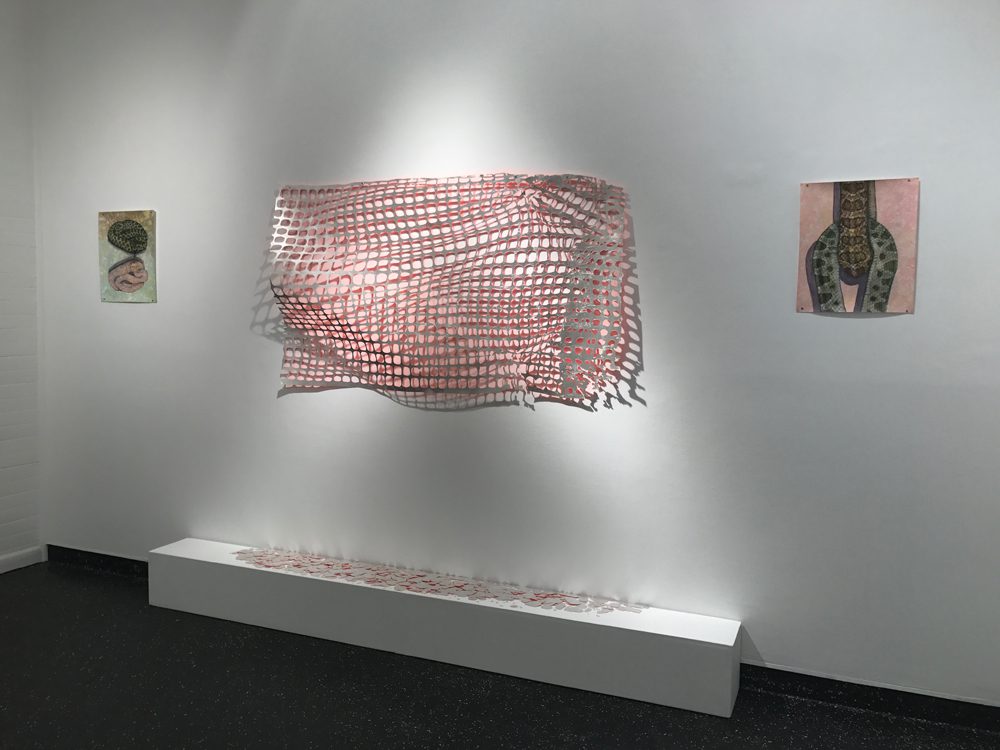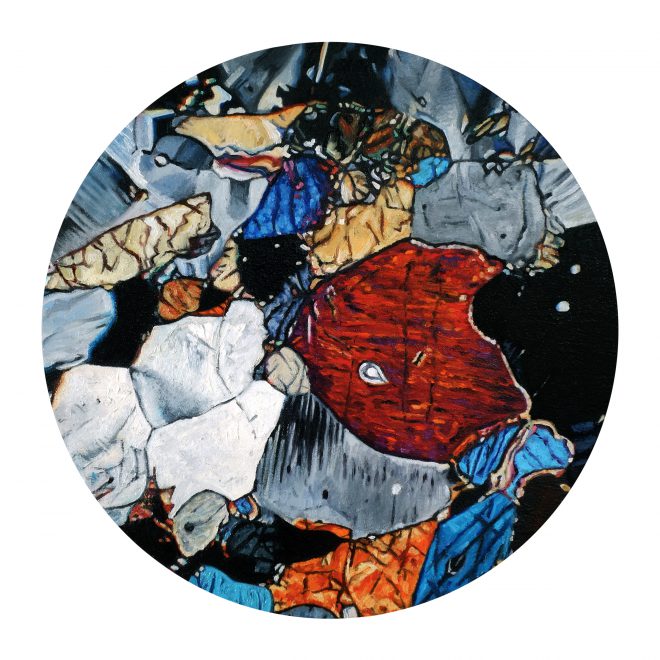Alchemy and Art: “Rare Earth” at The Front
Dillon Raborn reflects on the interconnectedness of three artists’ practices in a recent exhibition at The Front.

Installation view of works by Kelly A. Mueller and Amy Sacksteder at The Front, New Orleans. Courtesy the artists.
Arguably one of the most valuable lessons an art student can learn is the fruitfulness of peer collaboration. Within academic programs, bonds crystalize that can positively inform work for years to come. This is exemplified in “Rare Earth,” a recent three-artist exhibition at The Front. The artists—Jennifer Bock-Nelson, Kelly A. Mueller, and Amy Sacksteder—each received their MFAs from Northern Illinois University in 2004. Slowly separating into their current respective bases of Quincy, Illinois; New Orleans; and Ypsilanti, Michigan, the trio never lost contact in the years following school and reunited for this recent show—one laced throughout with the essential tenets of alchemy, the “golden art” itself. Alchemy is often loosely invoked by writers in accordance with parallel ideas of intermingling and transformation, but for “Rare Earth,” its use feels critical. The exhibition title itself immediately draws connotations of precious metals, the alchemist’s material aim, while the works within point to the mythic craft’s metaphysical goal.
The alchemist works toward the spiritual realization of the Hermetic maxim “as above so below,” which is inscribed on the legendary Emerald Tablet. Though distilled over centuries into many different versions, the sentiment invokes the dictates of a higher metaphysical plane that directly correlates to the physical reality of humankind. The idea finds visual realization in the curation of “Rare Earth” through recurring motifs and formal elements across the three artists’ practices. Surveying the gallery, Bock-Nelson’s photorealism instantly stands out. The viewer dives through her hyper-real paintings modeled after GoPro footage of natural waterways in various states of movement. These works intricately render rapid splashes and water-on-lens distortions in gouache and watercolor, each droplet given near-perfect visibility. More interesting, however, are her nine circular paintings depicting various microscopic views of metal and mineral surfaces, among them biotite, phlogopite, and sillimanite, all 2017. Hung in a three-by-three grid, these artworks beckon the viewer to ponder the surreality of the infinitesimal universes beneath their surfaces. This arrangement is reminiscent of the geometry of Sacksteder’s hypnotic piece The Other Side of Light, 2017—one of two hand-cut paper installations on view—which resembles a Tenax safety barrier. The sheen of silver leaf is complemented by a backing of bright orange paper, which reflects off of the white gallery wall. The hand-cut remains of Sacksteder’s paper pattern congregate in a pile beneath the piece, like freshly shed snakeskin.

Jennifer Bock-Nelson, Pyroxene, 2017. Courtesy the artist.
Sacksteder’s rippling surfaces are echoed in the undulating serpents of two small-scale acrylic and pencil works by Mueller. Narcissussss, 2016, presents two coiled vipers of opposing color schemes (green and pink) facing each other from above and below in reflective fashion, flickering tongues touching. To the right, SSSSwag, 2016, crops the tense intersection of two serpentine bodies, vertically locked in chain-link fashion, straining against one another. The snake is an icon historically tied to alchemy, often symbolizing eternity or the furnace through which lower metals traverse on their passage to higher states. Six large mixed-media paintings by Mueller feature snakes and snake-like ropes and tassels passively twisting around vicious flocks of birds and winged insects, rendered in discordant, yet delectable color-schemes. Far less peaceful than Sacksteder’s entrancing installations or Bock-Nelson’s invigorating, first-person waterscapes, the “as above, so below” tenet is here given a negative twist wherein the tribulations of the higher realm—that of the birds—is tied to the devouring connotations of the lower, terrestrial reptiles.
The complex relationships between the works in “Rare Earth” can be compellingly interpreted through the esoteric arts, but the exhibition received is not necessarily the exhibition conceived. In fact, this show contains an element of serendipity between the artists’ intentions. As Mueller noted in an email exchange, “…sharing our grad school experience and continuing to watch one another’s studio progress, we were aware enough of one another’s work to aim towards a common theme without having to talk extensively about it.” In other words, the success of “Rare Earth,” is just as much the result of conscious collaboration as it is the transformative, even alchemical, process schooling and peer interaction induces in artists, even into adulthood.
Editor's Note
“Rare Earth” was on view August 12–September 3, 2017, at The Front (4100 St. Claude Avenue) in New Orleans.



